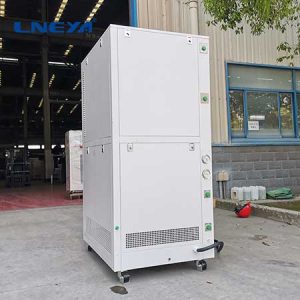What should be paid attention to in chiller manufacturing design?
(1). The welding method and sealing material shall be selected according to the working stability, pressure and fluid properties.
(2). Consider maintenance. This includes cleaning, servicing and maintenance of the lights and transport requirements.
(3). For the purpose of ensuring the uniformity of fluid distribution, the head, header, nozzle and diaphragm shall be designed.

(4). According to the highest working temperature and pressure, mechanical and thermal design and resistance calculation results, determine the materials and dimensions of each part to ensure the performance of the heat exchange dance during stable operation.
(5). In order to meet the performance design of heat and resistance, some parts must be checked for strength to avoid damage or waste due to insufficient strength under extreme working conditions.
1. Precautions for FL +5°C ~ +35°C Водяные охладители design.
(1) Determine the temperature of the fluid at both ends of the plate cooler, and then determine the physical characteristics of the fluid.

(2) The heat transfer temperature difference is calculated, and then the shell pass number of plate cooler is determined according to the temperature difference correction coefficient.
(3) Determine the type of plate cooler according to the temperature difference of fluid.
(4) Determine the value of the total heat transfer coefficient, then calculate the accurate heat transfer area of the plate cooler through the total heat transfer rate equation, and finally determine the specific model of the plate cooler.
2. How to clean the cooler?

After the cooler runs, due to the corrosion, erosion, scaling, coking and other reasons of the medium, the internal and external surfaces of the pipe have scaling to varying degrees, or even plugging. Therefore, thorough cleaning is required during maintenance. The common cleaning methods include air and water cleaning, steam cleaning, chemical cleaning and mechanical cleaning.
However, this traditional cleaning method, such as mechanical cleaning (scraping, brushing), high-pressure water cleaning, and chemical cleaning (pickling), has many problems when cleaning the tubular heat exchanger: the sediment such as scale cannot be completely removed, the acid solution forms holes, causing corrosion to the equipment, and the residual acid causes secondary corrosion or scaling corrosion to the raw materials, leading to equipment replacement.
In addition, cleaning waste liquid is toxic, which requires a lot of expenses for wastewater treatment. High efficiency, environmental protection, safety, non corrosive, biodegradable environmental cleaning agent can be selected, which not only has outstanding cleaning effect but also has no corrosion on equipment, and can guarantee the long-term use of the condenser.
 ЛНЕЙЯ
ЛНЕЙЯ
 简体中文
简体中文


















































































